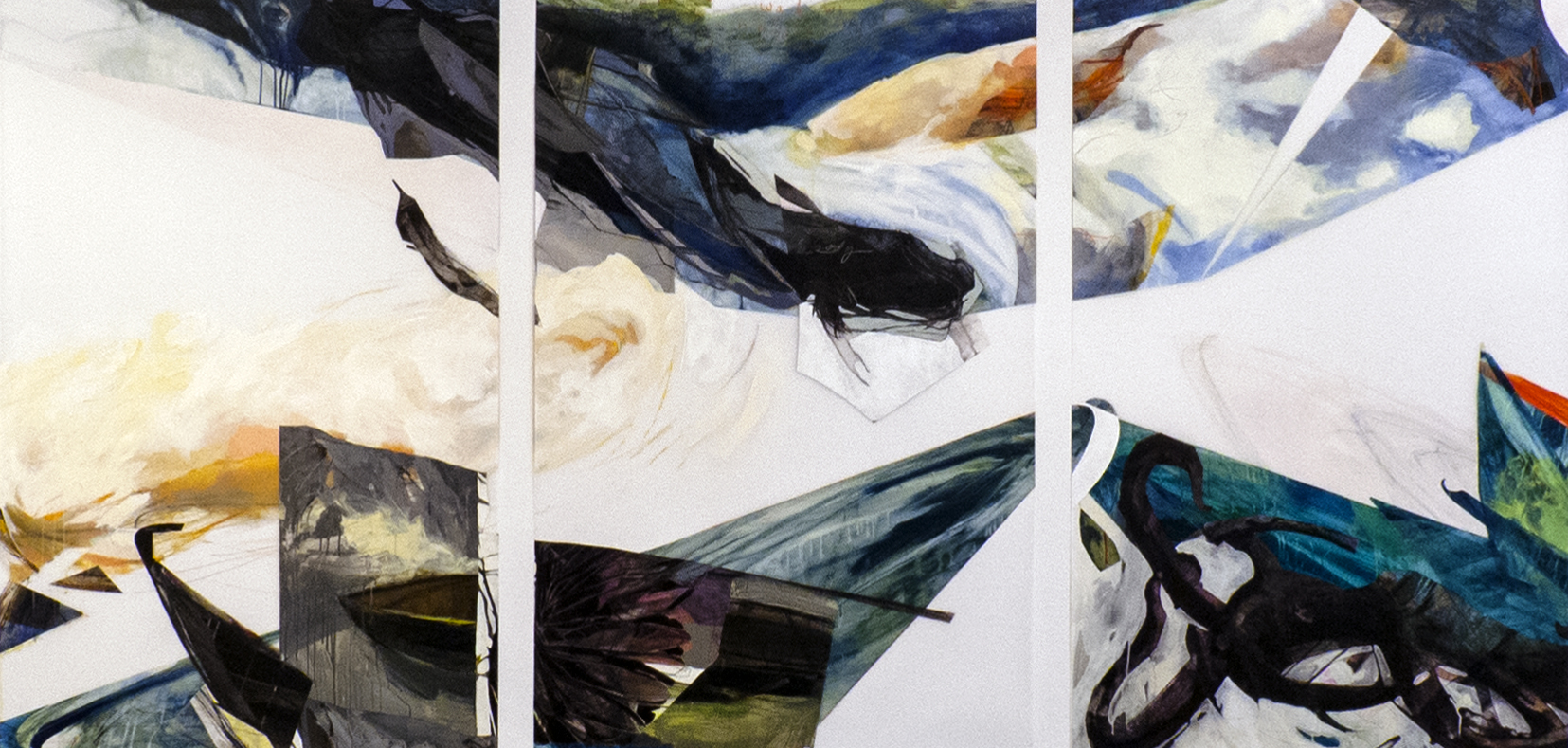The Collaboration
Diary of the One Swelling Sea is an (international) interdisciplinary collaboration between visual artist Corinne Duchesne, Ontario, Canada, composer Garrett Hope, Nebraska, and poet Jill McCabe Johnson, Washington. The work takes its title from Johnson’s book by the same name (MoonPath Press, 2013), which won the Nautilus Book Awards 2014 Silver Award in Poetry. Together, the collaborators have created a set of integrated works of art that invite the gallery attendee to fully engage with three modes of artistic expression: visual, verbal, and musical. The artists seek to create an immersive, disorienting, and re-orienting experience, transporting attendees from a familiar, land-based environment to an unfamiliar, sea-based environment. Surrounded by lush, expressive music that suggests a layered and complex song of the sea, plus Duchesne’s hauntingly rendered sea creatures—many of which are threatened or endangered—as well as video projections of the poems fading in and out with the tides, viewers experience the sense of being underwater as the walls surge and swell. The ever-shifting currents of the sea help facilitate ever-shifting currents of contemplation, consideration, and conversation.
The Poetry
The mythologized persona of the sea embodies a wise, yet innocent host who grieves the loss of his lovelies: the many species of marine life becoming extinct as a result of acidification of the oceans and other effects of global climate change. Primarily lyric, the poems resist traditional poetic and even stanzaic forms by drifting across the page in undulating lines that emulate the tides. An implied narrative of the Sea teetering on the verge of realizing his own mortality runs corollary to humanity’s dawning awareness of global climate change and the threat it poses to the planet. Unlike most poetry whose metaphors rely on shared cultural icons and the sensory phenomena of human experience, these poems employ a frame of reference based on the perspective of the sea. Like the oceans, the poetry is never static. In addition to the movement insinuated by line placement on the page, the poems also move with the tides in two different looping videos projected onto the exhibit space walls. In the tradition of writers such as William Wordsworth, Walt Whitman, and John Muir, who use Topophilia or love of the land, to inspire others to protect and care for the environment, Johnson uses what she calls Mariphilia, love of the sea. The poems’ other-worldly setting and cosmology draw extensively from the natural sciences, including marine biology, geology, meteorology, and astronomy. The scientific language adds to the beauty and exoticism of the poems, which serve as love songs: from the Sea to his lovelies, from the poet to her fellow humans, and from our short-sighted present to a more hopeful, long-term future.
The Visual Art
Duchesne’s artistic practice is informed by the emotional and philosophical considerations of grieving and reflect on the reality of loss within life. Loss is treated as a site of memory, and assumes a fluid representationalism that is at once fantastical as well as practical in its expression of grief. Similar to the accumulative nature of memory, Duchesne’s large, mixed-media drawings on Mylar fuse individually conceived works, including layered images, reclaimed segments of abandoned drawings, and expressive marks. The dialog that occurs among the constellated, encrypted symbols examines and questions Western culture's ideas about grief. In the drawings, death and dying are performed by objects of antiquity, culturally specific rituals, reliquaries and diverse iconography. The imagery centers on symbols of seascape and biomorphic organisms, human and animal, which relate aspects of suffering to physical experiences and memories. The passing of time, so important and mysterious in the process of loss and grieving, is suggested by many means, including the layering of transparent materials such as Mylar. Duchesne’s exploration of various media suggests detritus in the oceans and our lives, as well as echoed, ghost images that represent both unrequited love and unassuageable grief in works that bridge the genres of painting and collage.
The Music
Hope’s music for this collaboration blends acoustic and electronically produced sounds wedding musique concréte with total synthesis to create an aural environment.The electro-acoustic music conveys a dynamic soundscape of emotions to heighten the visual renderings as well as the poems. Additionally, the electronic medium affords a range of textures to complement the textures in Duchesne’s work, while also facilitating electronic manipulation of the human voice, declaiming the sea’s voice in the text. In this way, the music becomes the expressive and evocative connective tissue for the three disciplines, and underscores the emotional experience for the attendee. As a composer, Hope believes in stories as a means for listeners to enter the music, engage with the sounds, and experience the world in unexpected ways. Informed by his sense of social responsibility, his works often address social, political, and environmental issues, including depression, schizophrenia, rape, political activism, and spirituality, yet at times also expressing joy, excitement, adventure, and gratitude. In writing works for the sea, he has sought to portray a representational spectrum of the sea’s essence and experience, including the percussive and melodious voices of its inhabitant marine life, in order to mesmerize participants while immersed in the exhibit, then persist after for a lingering, thought- provoking impression.









